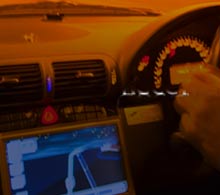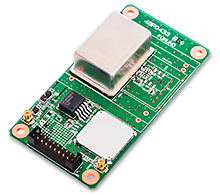Articles for ITS market
The Japanese automotive industry in 2020
- 3 turning points -
What will change in the Japanese automobile industry in 2020?
Looking, the relationship between the automotive industry and new technologies and services such as CASE (connectivity, automated driving, sharing, and electrification) and MaaS (mobility as a service) increased from 2010-2019.
In January 2020, at the New Year's meetings such as the Japan Automobile Manufacturers Association and the Japan Auto Parts Industries Association held in Tokyo, The opinion is that "2020 will introduce the era of social implementation of CASE and MaaS".
So what is the new direction for the Japanese automotive industry in 2020and beyond?
In my opinion, there are three things as shown below.
 Exhibition on the Tokyo Olympics at the Tokyo Motor Show 2019
Exhibition on the Tokyo Olympics at the Tokyo Motor Show 2019
 An exhibition on Toyota's automated driving technology. At CES in Las Vegas, USA
An exhibition on Toyota's automated driving technology. At CES in Las Vegas, USA
July 2020, Tokyo Olympics
The Olympics will be held in Tokyo for the first time in 56 years.
At the same time various demonstration tests on next-generation vehicles will be conducted on expressways in Tokyo and around Tokyo. Of interest are automated driving demonstration tests by automakers. The SIP (Cross-ministerial Strategic Innovation Promotion Program) launched by the Japanese government in 2015 has a strong importance during the first phase and until its final phase. For positioning information they utilize dynamic high-precision 3D maps and the Quasi-Zenith Satellite System, which is widely available all over Japan. As automakers they have been pushing for practical use of automated driving in Japan based on the concept of a cooperative areas that transcend business boundaries. A variety of hardware utilizing automated driving including passenger cars, commercial vehicles, heavy trucks, buses, and small mobility has been developed.
Another challenge is how to implement an automated driving project as the second phase of SIP. Also called post-SIP, it effectively refers to measures taken after the 2020 Tokyo Olympics.
In the second phase of SIP the company is aiming for social implementation of automated driving in a society that uses big data, utilizing 5G (5th) generation communication. To do so it is necessary to install 5G-related hardware infrastructure. The government has proposed a plan to install 5G data transceivers on 210,000 traffic signals nationwide by 2024. As for the installation cost a public-private partnership (PPP) that combines public and private funds is suggested, however no concise implementation plan has been determined.
Automakers still believe that infrastructure investment should be borne by public funds or highway-related companies. For this reason it is difficult to draw concise plans for utilizing big data in the second phase of SIP.
In the worst-case scenario, the 2020 Tokyo Olympics may fall into a state of inflection, with all-Japan peaking in automated driving development.
November 2020, US Presidential Election
Looking at the world, the US presidential election is the key. Who wins the next US Presidential election will have a major impact on CASE and MaaS in the global market.
In other words, between the current Trump administration and the previous Obama administration there has been a major shift in next-generation vehicle-related policies.
Will this policy be inherited and create further changes?
Or will the Democratic Party take power and return the policy of four years ago?
To give an example, regarding the electric vehicle (EV), the Obama administration has provided a huge amount of public support to private companies for the development of EVs and lithium-ion batteries under the Green New Deal policy. However, in many cases, the business was not continued and was virtually bankrupt, or acquired by a Chinese company. It was also pointed out that the company was not appreciative of public funding.
In response to the Obama administration's failure, the Trump administration has sought to limit the spread of EV for the time being and has not introduced additional public funds.
The situation for automated driving is similar to EV. In the latter half of the Obama administration, the US Department of Transportation (DOT) proposed legislation on automated driving and new town planning utilizing automated driving. Recently the Trump administration has suddenly rescinded this approach.
In addition, the Trump administration has completely reversed fuel economy regulations from the Obama administration. The Federal Environment Agency and the California Environment Agency have revised the de facto double standard. Stating that the federal government will unify fuel efficiency regulations, but will extend implementation to the second Trump administration.
May 2020, all models of all Toyota stores joint sales
Returning to Japan again, a major turning point for the automotive industry is the joint sales of all models at all stores at Toyota in May 2020. Currently, it is a virtual reorganization of the four Toyota sales channels.
At the same time in April 2020, Toyota's 33 parts distributors, Toyota's parts sales network and Tacti, a Toyota-owned company that conducts aftermarket equipment sales business called James will be merged.
This is the largest event ever in the automotive distribution world and has caused a huge ripple among industry stakeholders.
The effects are likely to affect distribution companies other than Toyota.
I will continue to cover the details of these three key points.
Writer introduction

Mr. Kenji Momota Automotive journalist
His major is the world automotive industry and he is also familiar with the energy industry, IT and the aging society problem as the related fields. He acts around the world based in Japan and USA and writes for the general magazines, the technology journals and the automotive related media etc.
He is also commentator of motor race and world's motor show on TV program based on his career of the driver of Indy Racing League and NASCAR. In recent years, he has been covering about a paradigm shift from developed countries to developing countries, the motorized vehicle like EV and the telematics.
FURUNO ITS Journal
Click here for the latest articles after 2022 (in Japanese)2022
- The "realistic" self-driving roadmap shown by the Japanese government and a hands-on report on the latest Subaru EyeSight X
- Will FCVs (Fuel Cell Vehicles) Become Popular? ~New Movement in Toyota and Honda~
- The 'Complete' online sales of new cars start in Japan. Will this new way of buying cars take root?
- Many Firsts! On-Site Report from Tokyo Auto Salon 2022 - The author, who knows what goes on behind the scenes, looks back on 40 years of history. -
2021
- "Moving toward zero traffic fatalities for four-wheeled and two-wheeled vehicles globally in 2050" ~Experience on Honda's latest safety technologies~
- Tsuneishi Shipbuilding's building and DX, an exclusive visit to the main factory
- Japan's Smart City: New Moves toward Practical Use
- When will self-driving buses (service cars) be put to "full-scale" practical use?
- Utilization vehicle data during disasters
- Toyota-led Connected Technology to Transform Commercial Vehicle Business -From light trucks to large trucks and buses-
- Toyota enters the connected car "Personalization" business
- Japanese automakers' carbon-neutral strategies swept up in ESG investment
- Drive experience of the latest autonomous vehicle models and advanced driving support systems
- Will carbon neutrality accelerate the trend to strengthen LCA (Life Cycle Assessment)?
- Semiconductor shortage exposes realities of the automotive industry
- Online Autonomous Driving Contest Enhancing development of Human Resources
2020
- What happens to CASE when gas cars are banned in Japan?
- When will Flying Cars be launched?
- Expectation vs. reality:Autonomous Driving in Japan
- V2X, Becoming increasingly important in autonomous driving
- Technology of Subaru “EyeSight X”
- Lifestyle-oriented French cars gain popularity in Japan
- Human-oriented smart cities are wanted
- MaaS and CASE, how would automotive industry change after COVID-19?
- The beginning of virtualization era, triggered by COVID-19
- Trend of EV shift and consumer demands
- TOYOTA Press conference about ADAS - Releasing algorithm for "sudden acceleration suppression during attempted sudden acceleration" free of charge -
- The Japanese automotive industry in 2020 - 3 turning points -
- "Using a smartphone while driving" and "Level 3 automated driving"
2019
- Motor show business model is at a turning point - Tokyo Motor Show Report -
- Commercialization and monetization of MaaS - ITS World Congress Singapore Report -
- Android Automotive pays attention to V2X - Report from the Frankfurt Motor Show 2019 in Germany -
- Automobile Distribution Revolution and DCM (Data Communication Module)
- Connected business potential and newly proposed "eMaaS" by Honda
- 5G services for practical use are multiplying
- Connectivity technologies attracting attention due to frequent traffic accidents
- Shanghai Motor Show report -SUV, EV, Automated car & 5G-
- Drone Business roadmap and updates to Michibiki (Quasi-Zenith Satellite System)
- MaaS (Mobility as a Service) "town development." Full-scale promotion for a national project
- CES organizer states "Data Period in 2020s." Transformation of the Automotive Industry in CES, US "-CES2019 Report-"
- "Return to Origin" directed towards the age of change, automatic operation and connectivity
2018
- New proposal for Private Car Automated Driving Level and other Hot 5G Technology Topics
- Standardized EV charging infrastructure concerns in Europe, US, Japan and China - Kobe EVS 31 field report -
- Touring a pure car carrier and a test drive of the latest hybrid car
- Planning stage products are exhibited at the newly established visualized mobility service "TOYOTA MOBILITY SHOWROOM".
- Potential “Community Car-share” program promoted by local residents
- CES Asia Report 2108
- Companies attempt new Vehicle-to-Infrastructure communications, including traffic volume measurements and vehicle positioning. -ITS Asia Pacific Forum in Fukuoka-
- Geneva show in Switzerland. Flying cars and MaaS (Mobility as a Service) were hot topics.
- EV (Electric Vehicle) proposals by country
- MaaS competition through service mobilization, M & A and technical field collaboration is accelerating. - The CES 2018 Report -
2017
- Big data’s initiative and fight for the automotive industry. Cooperation among companies becomes increasingly important.
- Connected car and road-to-vehicle communication automatic operation
- ETC (Electronic Toll Collection) and ETC2.0. Current situation and projected future
- Rapid development of sharing economy
- Germany is first to recognize level 3 automated driving
- ITS EU 2017 Field Reports -Automatic Operation and the eCall-
- From Infotainment to ITS, the competitive area is spreading in the car big data industry.
- GTC (GPU Technology Conference) Report and the de facto standardization of AI (artificial intelligence)
- Renesas' new challenge! "e-AI Solution" and "Renesas Autonomy"
- The Automobile industry is shifting from a manufacturing industry to a service industry.
- The movement toward accident countermeasures for aging drivers in Japan
- Fusion of ride sharing and fully automated driving is advancing in the USA.
2016
- Overview of the Quasi-Zenith Satellite System (QZSS) and advancements toward full-scale practical use including the Tokyo Olympic Games - G-space EXPO 2016 report-
- Japan’s automated driving project "SIP-adus" will be a large demonstration experiment.
- The International Home Care & Rehabilitation Exhibition. There were many car manufactures with exhibits booths at this show.
- Japanese car manufacturers starting to concentrate on strengthening the ADAS system
- A new movement of legislation for autonomous cars
- Cyber Security and “AGL”, the new OS for automotive are hot topics in the connected car industry
- “High precision 3D map” the key future of autonomous car and pedestrian dead reckoning
- Chinese “BAT” is accelerating their business in the EV (Electric Vehicle) market
- Tesla's original connection to Taiwan and the new transportation system technologies.
- "The main topic" of the Geneva Motor Show was how to strengthen "pedestrian protection"
- The probe data business is getting more competitive
- Reporting directly from the 2016 CES show "Data services will soon become the main revenue source of automotive industry"
2015
- Do the automated driving systems need the GNSS (Global Navigation Satellite System) ?
- ETC Version 2.0 is coming soon. A new service was announced at the Tokyo Motor Show and the possibility that is could be used as a device for older drivers.
- "Connected Horizon" and "eHorizon". Germany's leading parts supplier accelerates strengthening of "Big Data" for business



 Toyota dealers shake at all stores and all models
Toyota dealers shake at all stores and all models GPS/GNSS Receiver&Chips and Modules (positioning and timing)
GPS/GNSS Receiver&Chips and Modules (positioning and timing)